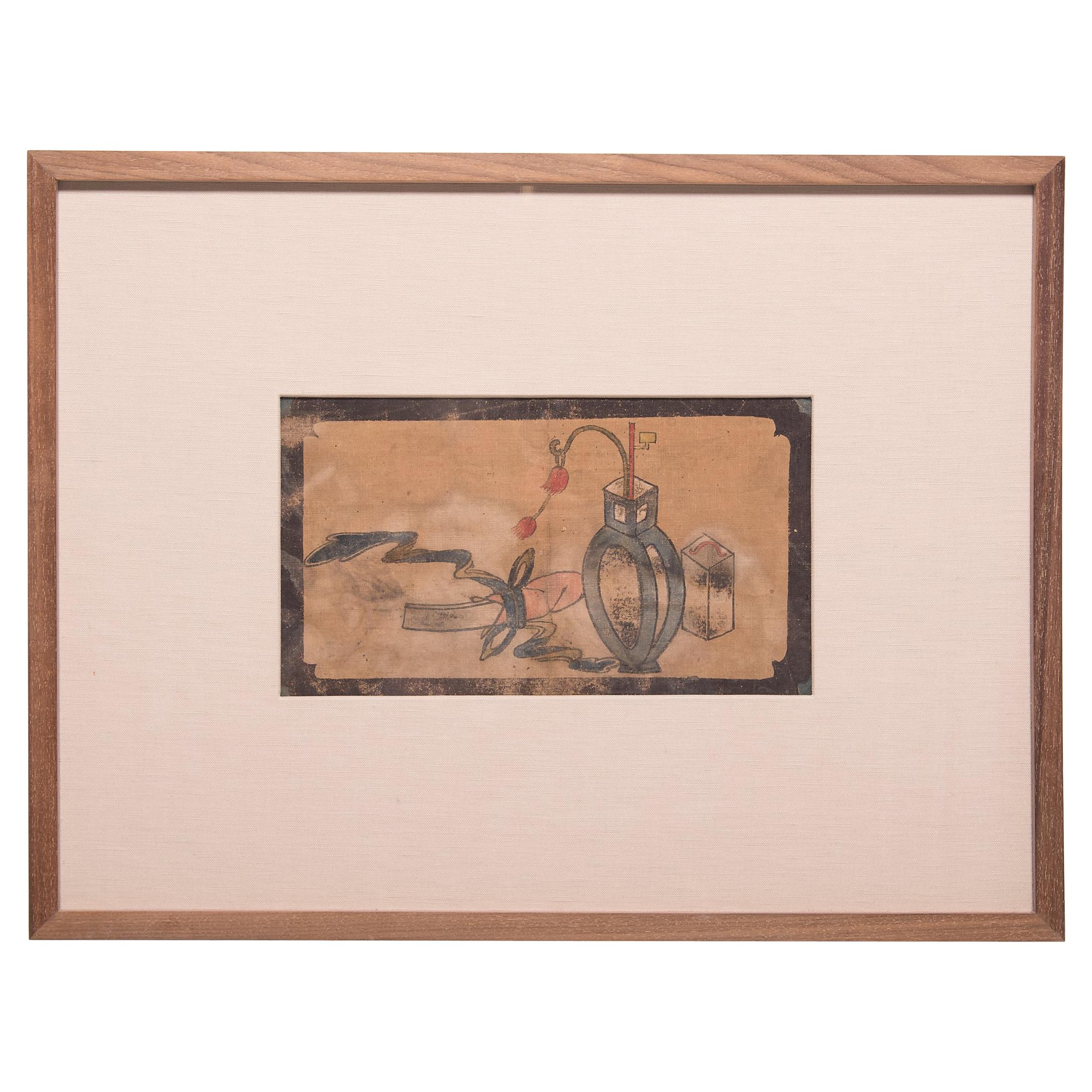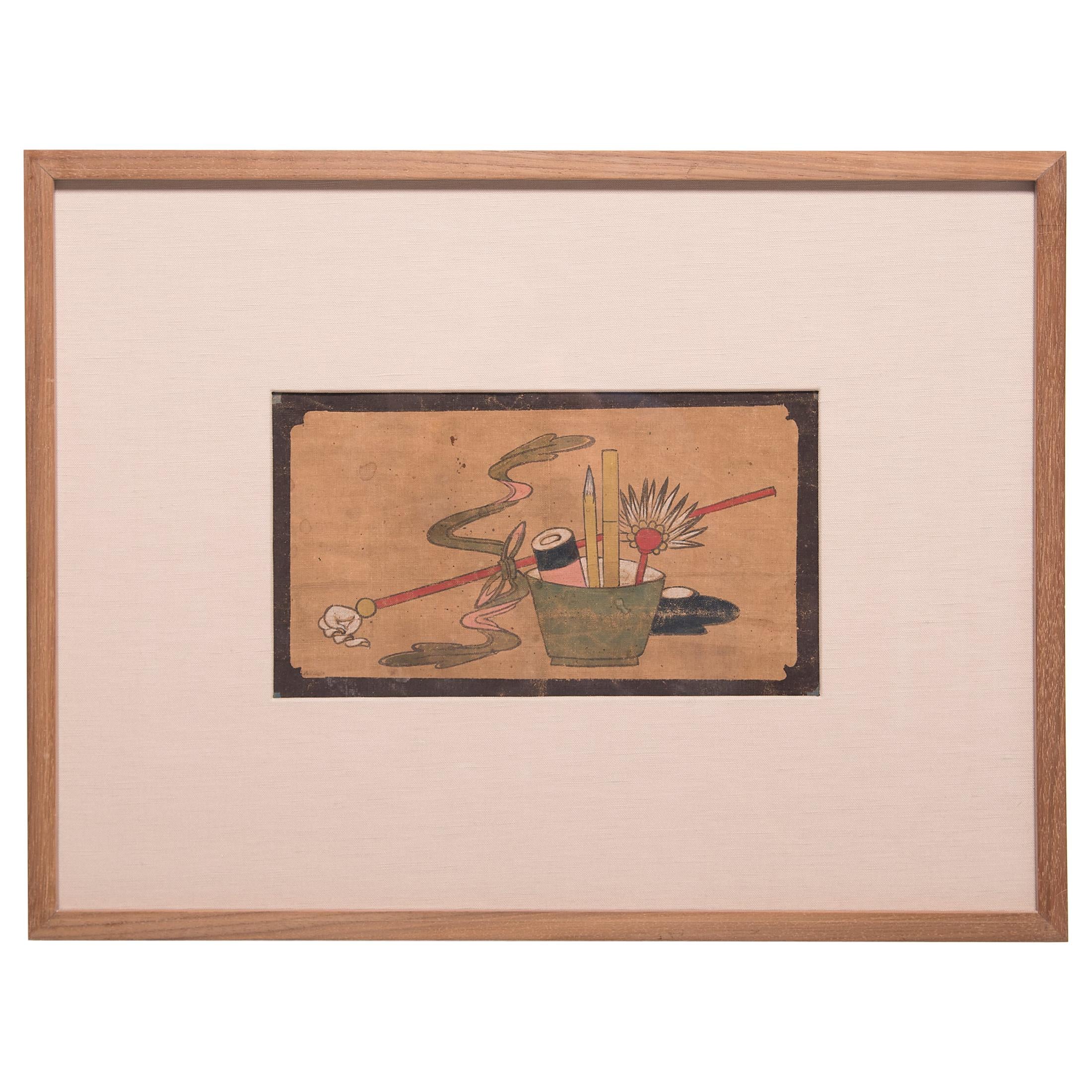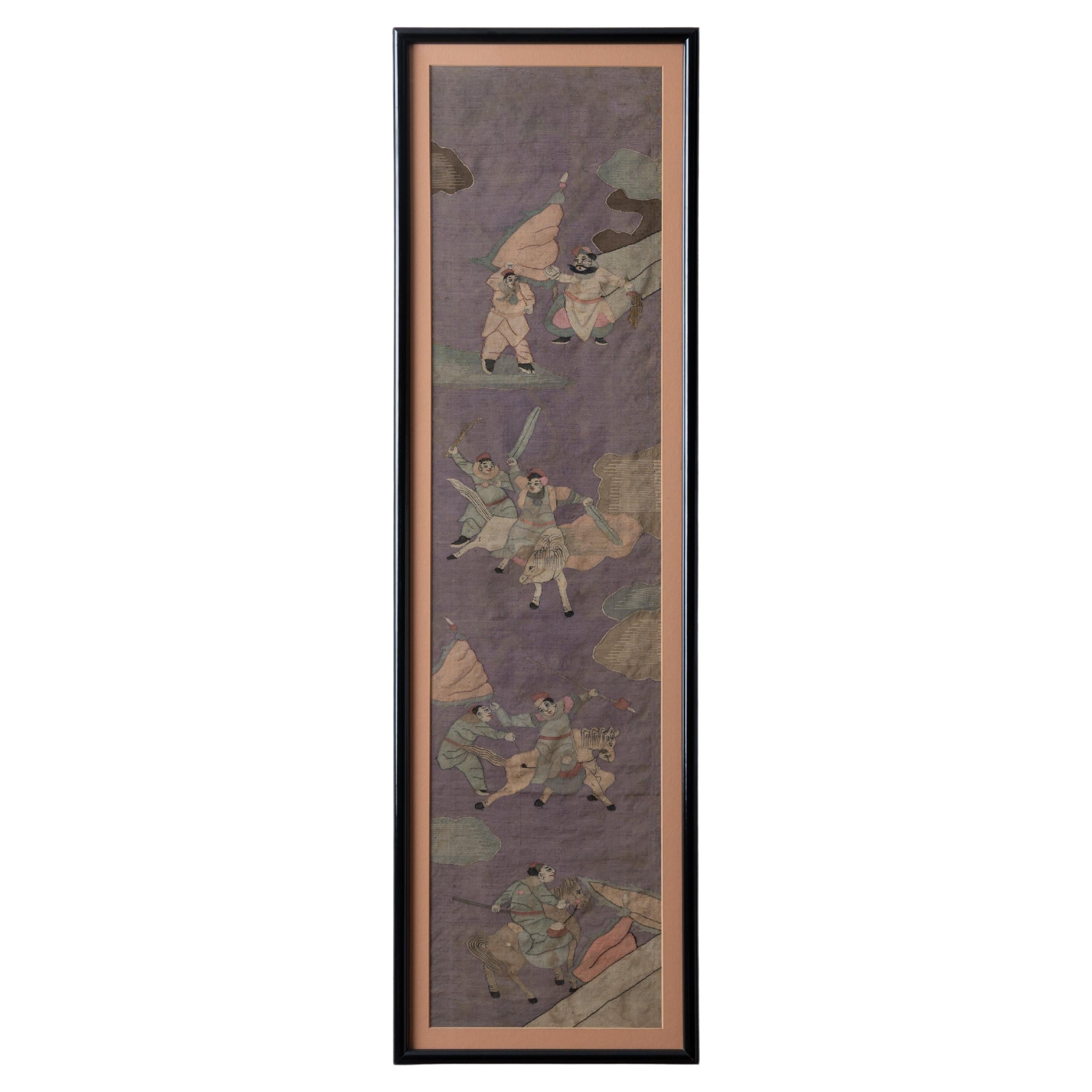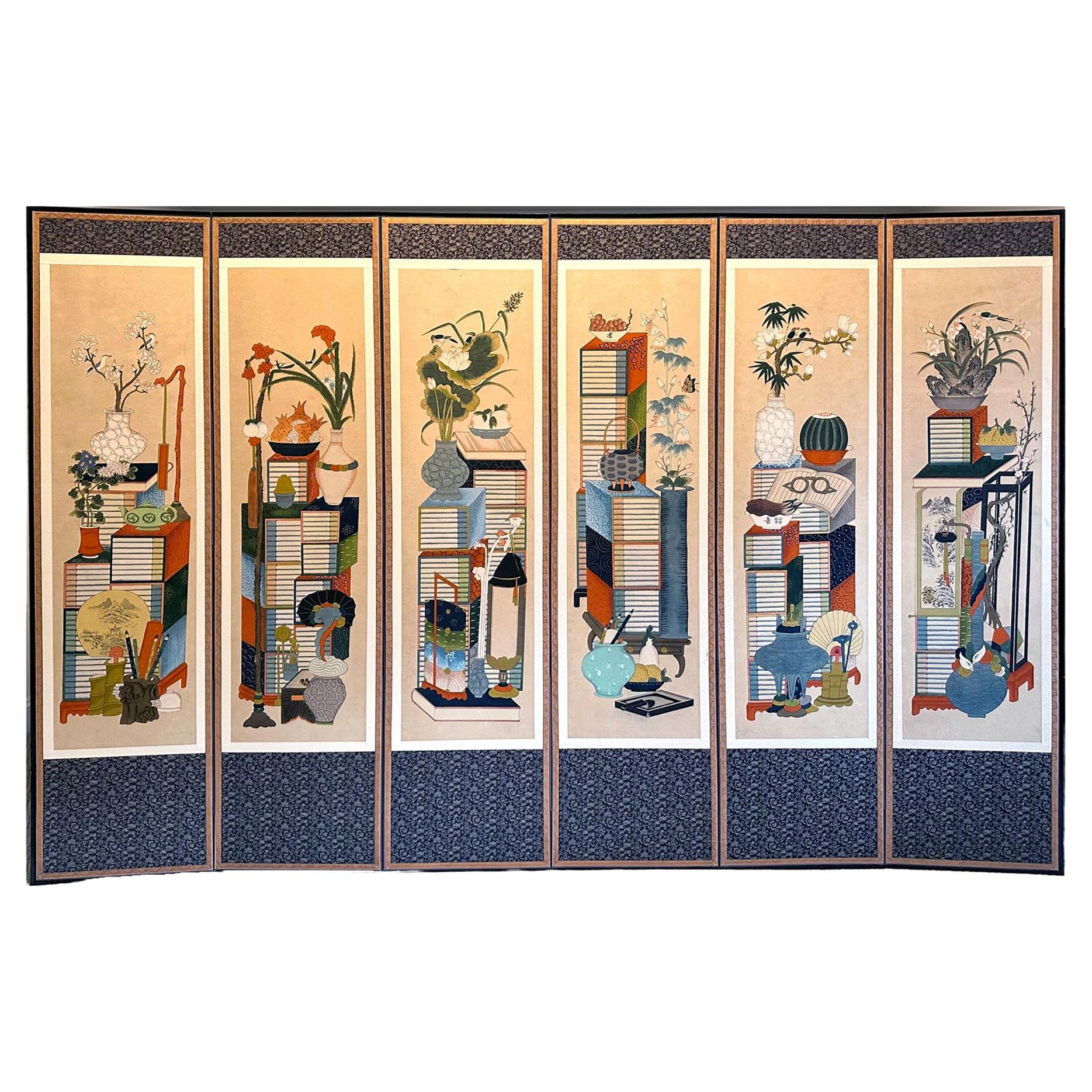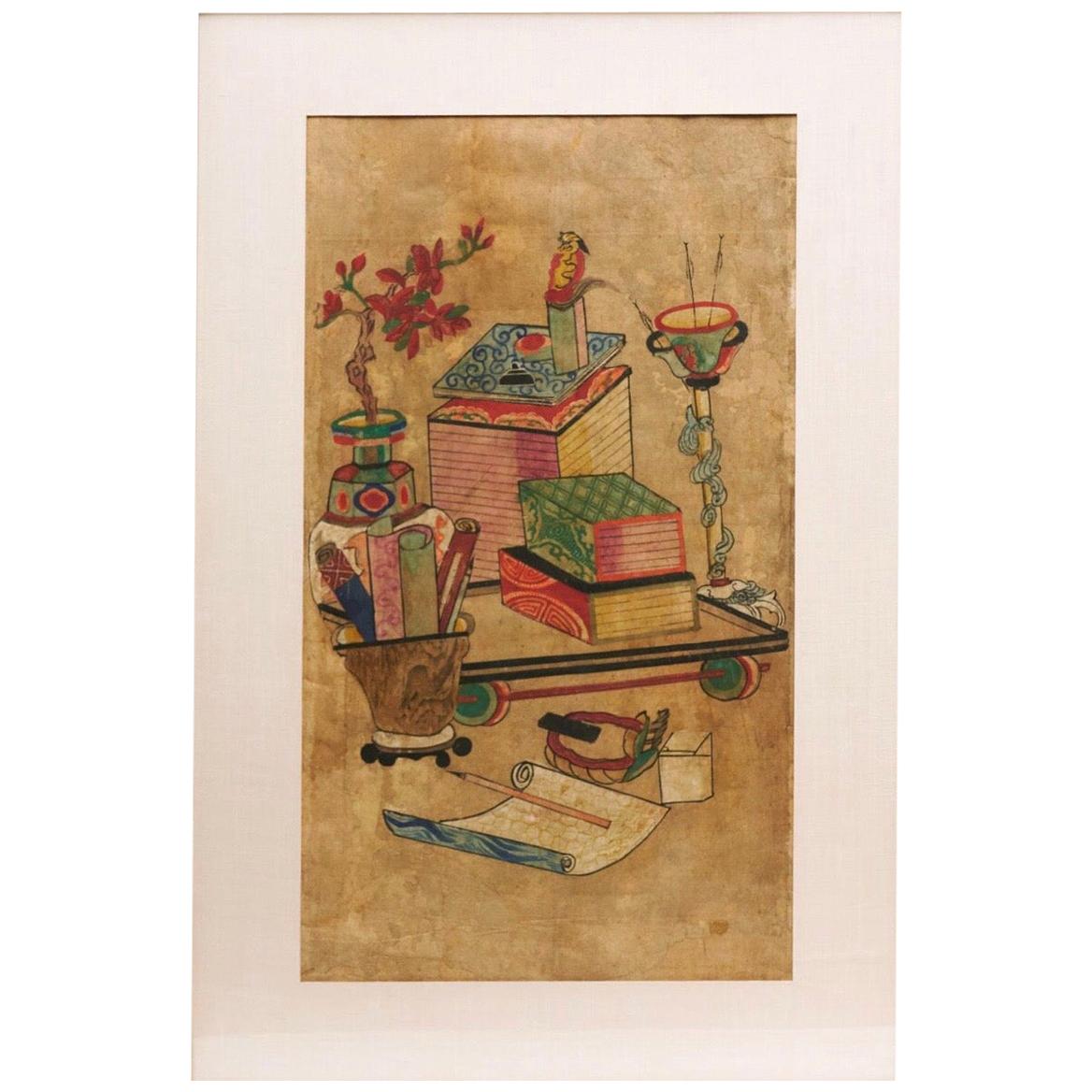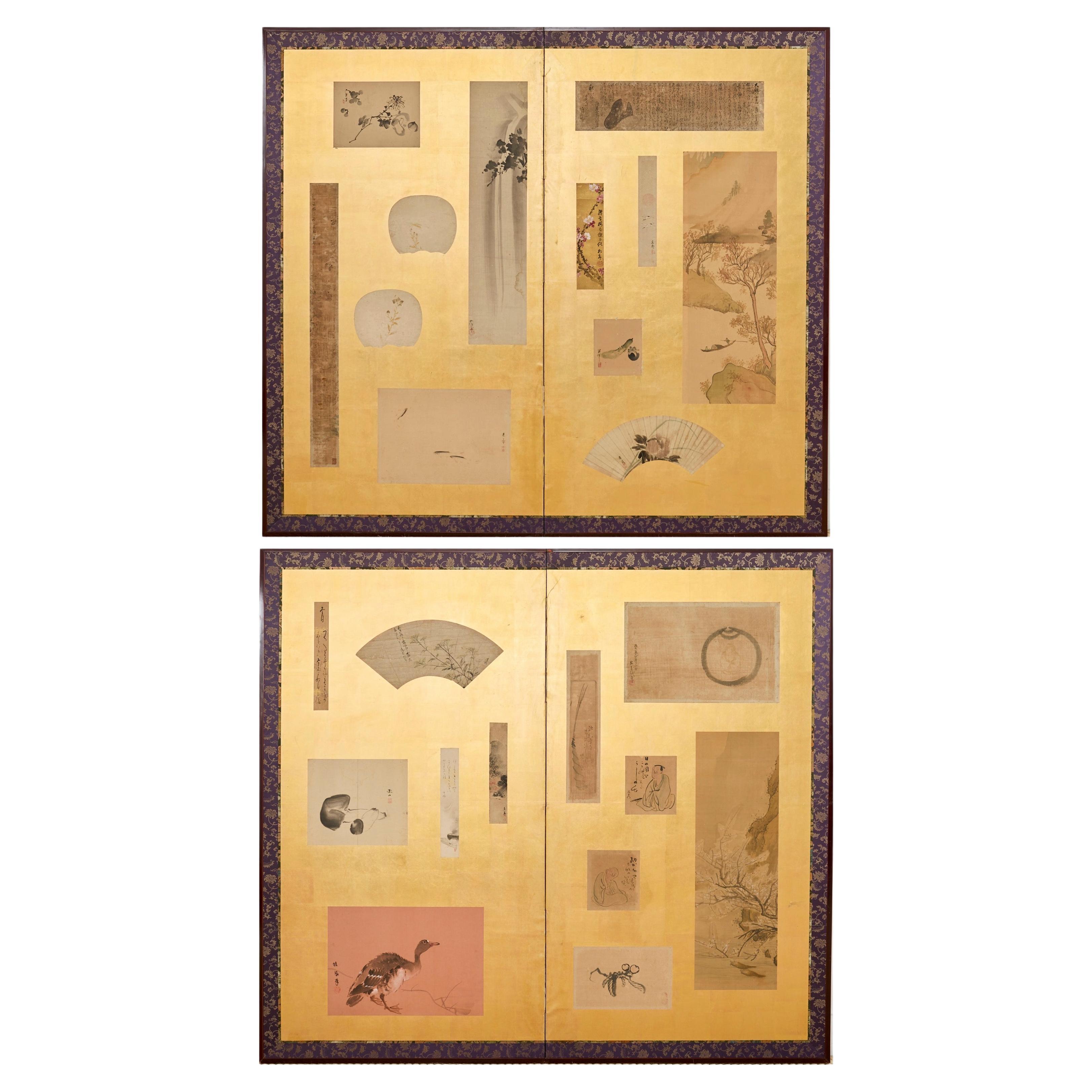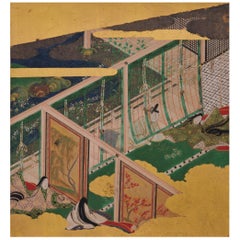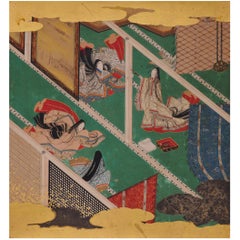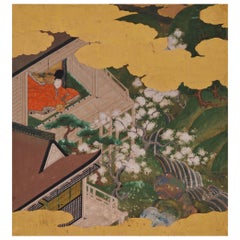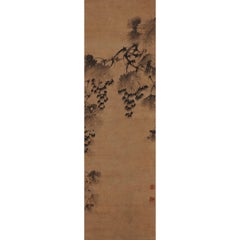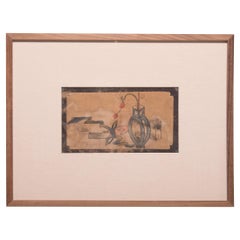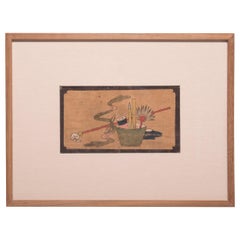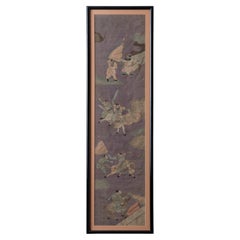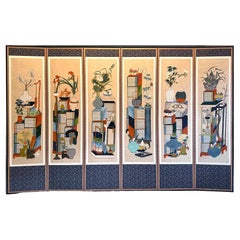Items Similar to Korean Chaekgeori painting. 19th Century Joseon. Books & Scholars’ Accouterments
Want more images or videos?
Request additional images or videos from the seller
1 of 6
Korean Chaekgeori painting. 19th Century Joseon. Books & Scholars’ Accouterments
$12,000
£9,111.88
€10,420.12
CA$16,765.74
A$18,647.16
CHF 9,736.97
MX$226,916.14
NOK 124,355.95
SEK 116,623.94
DKK 77,769.35
Shipping
Retrieving quote...The 1stDibs Promise:
Authenticity Guarantee,
Money-Back Guarantee,
24-Hour Cancellation
About the Item
Books and Scholars’ Accouterments; Chaekgeori
Second half of the 19th century
Korean framed panel. Ink and color on paper.
This Korean Chaekgeori painting depicts two open shelves in a rough approximation of Western linear perspective, creating an appearance of three-dimensional depth. The lower shelf displays Chinese porcelain, an archaic Chinese bronze and a clock set against a luminous rear panel of deep blue. The upper shelf is stacked with books.
Of the various kinds of Korean decorative painting which were popular towards the end of the Joseon period (1392-1897), Chaekgeori or chaekgado is the genre that most embodies the spirit and aspirations of the period’s literati. The genre depicts books and other material commodities as symbolic embodiments of knowledge, power and aspiration. Chinese curiosities from the Qing dynasty (1644–1912) entered the homes of the upper classes of Korea during this period, and this is reflected in these paintings. Books mingle with scholarly objects, all competing for prominence of place and the attention of the viewer. The clock is an example of new technology brought to East Asia via Jesuit missionaries and Western merchants.
This panel is the work of a Korean court painter who created paintings for the elite of Korean society. There was a complex family lineage of professional painters and they transmitted painting themes and styles within those families. The elements of this panel, including the Chinese bronze and porcelain and the clock are reproduced virtually identically in a number of important Chaekgeori screen paintings dating to the second half of the 19th century. It is directly comparable to a work by Yi Taek-gyun in the Cleveland Museum of Art. Its size is highly unusual. It is a single sheet measuring 20” across and 36” high (51cm x 92cm). The question remains as to whether this was originally designed as a single panel or whether it was originally part of a folding screen. Thus far Korean Chaekgeori have only been discovered in folding screen formats of 8, 10 and 12 panels. The width of these screen panels ranges from 8.25” to 13.75” (21cm to 35cm). The 20” width of this panel lends substantial weight to the theory that it was painted to be displayed as a single panel as it is currently presented.
- Dimensions:Height: 47.5 in (120.65 cm)Width: 26.5 in (67.31 cm)Depth: 0.75 in (1.91 cm)
- Style:Edo (Of the Period)
- Materials and Techniques:
- Place of Origin:
- Period:
- Date of Manufacture:Circa 1880
- Condition:Replacements made: Recently completely remounted and reframed. One replacement section of painting/paper at the lower right corner. The was restored during a previous restoration. Refinished. Minor losses.
- Seller Location:Kyoto, JP
- Reference Number:1stDibs: LU2472339273642
About the Seller
5.0
Recognized Seller
These prestigious sellers are industry leaders and represent the highest echelon for item quality and design.
Established in 2001
1stDibs seller since 2016
70 sales on 1stDibs
Typical response time: 6 hours
- ShippingRetrieving quote...Shipping from: Kyoto, Japan
- Return Policy
Authenticity Guarantee
In the unlikely event there’s an issue with an item’s authenticity, contact us within 1 year for a full refund. DetailsMoney-Back Guarantee
If your item is not as described, is damaged in transit, or does not arrive, contact us within 7 days for a full refund. Details24-Hour Cancellation
You have a 24-hour grace period in which to reconsider your purchase, with no questions asked.Vetted Professional Sellers
Our world-class sellers must adhere to strict standards for service and quality, maintaining the integrity of our listings.Price-Match Guarantee
If you find that a seller listed the same item for a lower price elsewhere, we’ll match it.Trusted Global Delivery
Our best-in-class carrier network provides specialized shipping options worldwide, including custom delivery.More From This Seller
View AllJapanese Painting, 17th Century, Tale of Genji, Fujibakama, Tosa School
Located in Kyoto, JP
Purple Trousers (Fujibakama), Illustration to Chapter 30 of the Tale of Genji (Genji Monogatari)
Tosa School (second half of the 17th century)
Ink, ...
Category
Antique Late 17th Century Japanese Edo Paintings and Screens
Materials
Gold Leaf
Japanese Painting, 17th Century, Tale of Genji, Makibashira, Tosa School
Located in Kyoto, JP
The Handsome Pillar (Makibashira), Illustration to Chapter 31 of the Tale of Genji (Genji Monogatari)
Tosa School (second half of the 17th Century)
I...
Category
Antique Late 17th Century Japanese Edo Paintings and Screens
Materials
Gold Leaf
Japanese Painting, 17th Century, Tale of Genji, Tosa School
Located in Kyoto, JP
Illustration to an unidentified chapter of the Tale of Genji (Genji Monogatari)
Tosa School (second half of the 17th Century)
Ink, pigment, gofun and...
Category
Antique Late 17th Century Japanese Edo Paintings and Screens
Materials
Gold Leaf
Korean Painting, Wall Panel, 17th Century Ink Grapevine
Located in Kyoto, JP
Grapevine
Anonymous. Korean, 17th century.
Wall panel, ink on paper.
Upper seal:
Kou Kinun in
Lower seal:
Kaigen
Dimensions:
Measures: 98.5 cm x 29.5 cm (39” ...
Category
Antique 17th Century Korean Other Paintings and Screens
Materials
Wood, Paper
Japanese Screen Painting, Circa 1700 'Tales of Ise' by Tosa Mitsusuke
By Tosa Mitsusuke 1
Located in Kyoto, JP
A six-fold Japanese screen by Tosa Mitsusuke (1675-1710), Japan 17th-18th century, Edo period.
The signature reads Shoroku-i ge Tosa sa Konoe Shogen Mit...
Category
Antique Late 17th Century Japanese Edo Paintings and Screens
Materials
Gold Leaf
Mid 19th Century Japanese Screen Pair. Flowers & Birds of the Four Seasons.
Located in Kyoto, JP
Shioka Sorin (1781-1850)
Flowers & Birds of the Four Seasons
Pair of six-panel Japanese Screens. Ink, gofun and pigments on silk.
Dimensions (each screen): H. 91.5cm x W. 285cm (3...
Category
Antique Mid-19th Century Japanese Edo Paintings and Screens
Materials
Silk
You May Also Like
"Scholar's Treasures" Chinese Painting, c. 1850
Located in Chicago, IL
A scroll and a small lantern depicted in this 19th century painting suggest the romantic notion of a Chinese scholar painting in the evening hours. Re...
Category
Antique Mid-19th Century Chinese Qing Paintings and Screens
Materials
Fabric
"Treasures of the Scholars' Studio" Chinese Painting, c. 1850
Located in Chicago, IL
With careful brushwork, this 19th century painting honors the four treasures of the scholar's studio - paper, calligraphy brush, ink, and inkstone. Essenti...
Category
Antique Mid-19th Century Chinese Qing Paintings and Screens
Materials
Fabric
Chinese Kesi Panel, 19th Century
Located in Savannah, GA
A Chinese silk embroidered kesi panel, Qing Dynasty, 19th Century.
12 inches wide by 40 inches tall
Category
Antique 19th Century Chinese Qing Textiles
Materials
Silk, Glass, Wood
Korean Folding Chaekgeori Painted Scholar Floor Screen
Located in Atlanta, GA
A six-panel painted folding floor screen from Korea circa early 20th century. This type of screen is called Chaekgeori (books and things) which is quite unique to Korea. It became popular at the end of 18th century favored and encouraged by King Jeongjo (1752-1800) as a political tool to promote social conservatism such as the traditional Confucianism value, especially considered important in a time when waves of new ideology influx came to Korea. Initially commissioned for the royal court, they became increasingly popular with the scholars of noble and affluent households and were used widely in their halls and studies. Early screens were painted with trompe-l’oeil bookcases displaying books and arrays of collectibles. Later, the bookcases were eliminated to focus on the assemblage of neatly stacked books and objects of scholarly pursue. On this screen, the six panels were neatly presented and framed in woven brocade borders. Among the stacked volumes, one can find many fine porcelain vases with flowers, potted orchids, pen holders with brush pens and scroll paintings, incense burner, ink stone, teapot, fan with ink painting, vessels of fruits, exotic plants such as lotus, plumeria and even a pair of glasses. It feels like a pleasant visual measure hunting for the viewers. Several words in Chinese found their way into the picture as well, including filial (xiao), longevity (shou) and luck (fu).
The painting was done in a meticulous way with no details overlooked and also with a rather western still-life dimensional perspective. In a rather unusual maximal but also minimalistic way, the screen exudes a historical charm with a folky flair but appears modern at the same time.
Each panel is 17.5"w by 70.2"h.
For general information on the subject see reference: Chaekgeori the Power and Pleasure of Possessions in Korean Painted Screens...
Category
20th Century Korean Folk Art Paintings and Screens
Materials
Brocade, Silk, Wood, Paper
Korean Chaekgeori 'Library Scroll' Watercolor, Yi Dynasty, Late 19th Century
Located in Spencertown, NY
Watercolor and ink on rice paper depicting scholar's objects. Unframed image H. 27" W. 15"
Framed H. 34.5 W. 22.5.
Category
Antique 1880s Korean Other Paintings
Materials
Paper
Pair of Japanese Two Panel Screens Edo Period Vignettes
Located in Rio Vista, CA
Impressive pair of Japanese two-panel byobu screens featuring late 18th-century edo period applied vignettes, poems, and paintings in various formats over a dramatic gold leaf square...
Category
Antique 18th Century Japanese Edo Paintings and Screens
Materials
Gold Leaf
More Ways To Browse
Stack Of Books
Qing Dynasty Painting
Antique Painting Clock
Qing Dynasty Screen
Cleveland Antique Furniture
Painted Paper Panels Chinese
Chinese Court Paintings
Korean Panel
Two Panel Folding Screen
Chinese Porcelain Screen
12 Panel Chinese
Chinese Antique Clocks
Antique China Clock
Antique Korean Painting
Antique Chinese Folding Screens
12 Panel Screen
Clock Shelf Antique
Joseon Porcelain
